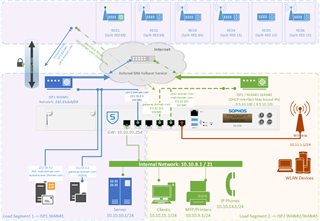Hi all,
I have a question on the correct configuration of SNAT in a Dual WAN Environment. Or if it's the right approach to do it at all.
As mentioned I have 2 ISPs connected to the UTM. They are both set up as active Uplink Interfaces, the slower Connection is weighted 0, the faster one 100, the purpose is distributing traffic manually over the two lines as needed with Multipath rules but having WAN Failover in place.
- Multipath rules are used to route services over the specific Interfaces (skipping rule on Interface error active for failover).
- Internal Network is masqueraded with Primary Interface Address -> Uplink Interfaces.
- DNAT Rules are in place for each public IP Address to ensure that traffic gets to the correct internal destinations over both ISP connections.
This far everything works fine!
Now I'm trying to make sure that traffic from several internal servers leave with the correct public IP for each Provider. The behaviour of outgoing traffic at this point is, that the Primary Interface address of the active WAN Uplink is used - which is as expected because of the masquerading rule above.
But I need several Hosts/Services use a specific public IP of the current active WAN Connection. Therefore I tried 2 SNAT Rules for each ISP like the following example for our Remote Desktop Session Host:
SNAT1: Traffic selector: RDSH1(Internal Host Address) -> RDSH-GW-Ports (HTTP/HTTPS) -> Internet IPv4 Source translation: WAN #1 RDSH1 (Additional Address)
SNAT2: Traffic selector: RDSH1(Internal Host Address) -> RDSH-GW-Ports (HTTP/HTTPS) -> Internet IPv4 Source translation: WAN #2 RDSH1 (Additional Address)
But it doesn't seem work. If both WAN Interfaces are up, traffic is always coming from SNAT1 rule WAN #1 RDSH1 Address instead of SNAT2 which would be the actively used ISP as defined by Multipath. Changing order makes no difference. But I can verify that the Multipath rule is working and traffic is leaving over the right WAN Interface (WAN #2). I can also confirm that the right DNAT rule is working for WAN #2 through Firewall log so the correct incoming public IP is used, but the answer is masked with the wrong source IP from the other SNAT1 Rule.
Strange thing is, an equal configuration for our mail Server seems to be working. The only difference in the config is the traffic selector of the SNAT rule, which is any instead of the host:
SNAT3: Traffic selector: ANY -> SMTP -> Internet IPv4 Source translation: WAN #1 MAILSVR1 (Additional Address)
SNAT4: Traffic selector: ANY -> SMTP -> Internet IPv4 Source translation: WAN #2 MAILSVR1 (Additional Address)
But I can not use ANY as traffic selector for the Remote Desktop Session Host, as I have several other Server with the same Service set (HTTP/HTTPS) which need to take their own routes.
In another post, I read a reply from BAlfson which suggested that it might be smarter to use Masquerade Rules instead of SNAT/DNAT rules to route the traffic? May be this would be the proper way to do it?
I'm really stuck here, may be anyone could point me in the right direction?
Thanks a lot in advance!
This thread was automatically locked due to age.



